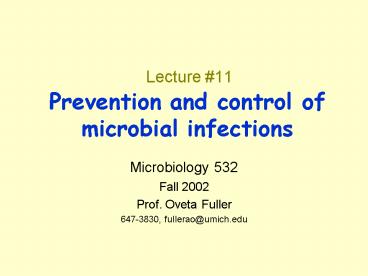Lecture PowerPoint PPT Presentation
1 / 30
Title: Lecture
1
Lecture 11 Prevention and control of microbial
infections
- Microbiology 532
- Fall 2002
- Prof. Oveta Fuller
- 647-3830, fullerao_at_umich.edu
2
Infectious diseases
- Replication of microbe
- host defenses infectious disease
3
Prevention and Control of Microbial Infection
- Interaction of microbes with host immune system
determines - - outcome of an infection and disease
- - ways to control those infections
- - effects on populations
4
(No Transcript)
5
Three things all viruses must do
- 1 - Replicate to make progeny
- 2 - Spread and transmission
- - Evade host defenses
- Outcomes of these determine
- pathogenesis
6
3. Evade host defenses
- Evade anti-viral defenses
- Struggle between virus and host
- Virus must evade long enough to replicate and
transmit, or establish latent or persistent
infection - Disease is unintended consequence of
- how a virus solves three problems
7
Patterns of disease
- acute
- persistent
- chronic
- latent
- subclincal
8
Types of Prevention and Control
- Natural defenses
- Host immune defenses
- Vaccines- prevent viral infection
- Antiviral chemotherapy- reduce viral
- disease after infection
9
Types of host defenses
- Natural barrier defenses
- Innate defenses
- (phagocytes, complement, interferon, NK )
- Adaptive immune defenses
- (antibodies, killer T-cells)
10
Natural host defenses
- - defend against a variety of microbes
- - include
- skin epidermis layer
- pH and enzymes of stomach
- ciliation of respiratory tract
- mucosal surfaces
- blood brain barrier
11
Activation of immune response
- Natural barrier is breached
- Innate immune system quick response
- (complement and macrophages)
- (natural killer, neutrophils, monocytes)
- Cytokine activation eg. TNF, IF g
- Dendritic cells communicate to adaptive system by
migrating to lymph node
12
Adaptive host defenses
- Humoral immunity
- antibody mediated immune responses
- antibodies, IgA, IgM, IgG
- interferons
- Cellular immunity
- cytotoxic T-cells lyse infected cells
- Interferons and other cytokines
13
Cooperation of host defenses
- Macrophages, monocytes, neutrophils
- Complement destroys, signals, recruits
- Interferon warning, cell shutdown
- Natural killer cells (kill, dont kill)
- Activators- interferon, cytokines
- Inflammatory response
- (fever, fatigue, malaise, tissue damage)
14
Weaknesses of immune defenses
- Innate
- - recognizes bacteria better than viruses
- - some viruses sneak past detection
- Adaptive
- - specific but slow to react
- - less efficient in infants and aged
15
Biologicals in viral control
- Immunoglobin therapy
- Interferons
- three types a, b, g
- specificity for RNA gt DNA
- mechanism of action
- toxicities
16
Preventions and controls Vaccines
- Prime immune response without causing actually
viral disease - Properties of viral vaccines
- given usually before disease encounter
- can be given once or repeated
- can vary in protection
17
Historical perspective
- Vaccine success stories
- smallpox, yellow fever, polio
- measles, mumps, rubella
- Criteria for eradication
- - no animal reservoire
- - effective vaccine available
- - one stable virus strain
- - easily recognizable disease
- - infection provides lifelong immunity
18
Types of vaccines
- Usually provided before infection
- Live attenuated
- Killed
- Subunit vaccines
- (see Jawetz Table 30.10,
21st)
19
Live vaccines
- Use attenuated virus
- advantages
- active full immune response
- longer lasting immunity
- disadvantages
- reversion of virulence
- problems in immunocompromised hosts
- spread to contacts
20
Killed virus vaccines
- Some process to inactivate virus
- advantages
- stability
- no risk of infection
- disadvantages
- little cellular or mucosal immunity
- shorter duration of immunity
- effect of partial immunity
21
Vaccines (cont.)
- Alternative vaccine types
- subunit
- engineered live
- vector vaccines
- What are some high priority diseases for
development of vaccines or control? - What are some complications to successful
development?
22
Human vaccines licensed in USA
23
Considerations for vaccine development
- What virus component works?
- What form of vaccine?
- live, attenuated, subunit
- When to give to host?
- Site of inoculation
- Safety and storage
- Measure response to vaccine
24
Prevention and controls Anti-virals
- Goals of chemotherapy
- - reduce severity of disease or outcome
- - specifically interrupt events unique to
- replication of virus
- - do not adversely affect the host
- selective toxicity
25
Anti-viral considerations
- - give after or during infection
- - selective toxicity
- - defined target site
- - side effects
- - duration and range of effectiveness
- - development of resistance
- - economical market
26
Some current anti-virals
- Acyclovir (acycloguanosine)
- Vidarabine ( Ara-A, adenosine arabinoside)
- Ribavirin (virazole)
- Amantadine (adamantanamine)
- Azidothymidine (AZT)
- WIN 51711 (Disoxaril)
- Ganciclovir (DHPH)
- Ritonavir
- Saquinavir (see Jawetz Table 30.7-6)
27
Criteria for good research model system
- Ideally will duplicate pathogenicity of natural
host - - or microbes similar or proportionate
- - see same patterns of pathogenicity
- - same natural routes of infection
28
How to determine that a virus causes a certain
disease Kochs postulates
- Microbe must be associated with infectious
disease - Isolate virus from diseased host and prepare a
pure culture - Inoculate pure culture into healthy host who
becomes sick with the same disease - Isolate the same microbe from the new sick host
29
Kochs molecular postulates
- Gene or factor should be associated with
pathogenic condition or phenotype - Inactivate or alter this gene should lead to
measurable decrease in virulence or pathogenicity - Specifically replace gene should restore virulence
30
Viral survival strategies
- Gain entry
- Multiply at local site
- Find suitable niche
- Overcome or subvert host defenses
- - outrun
- - antigenic change
- - hide in host
- - mimic host component
- - inactivate/down-regulate host response

